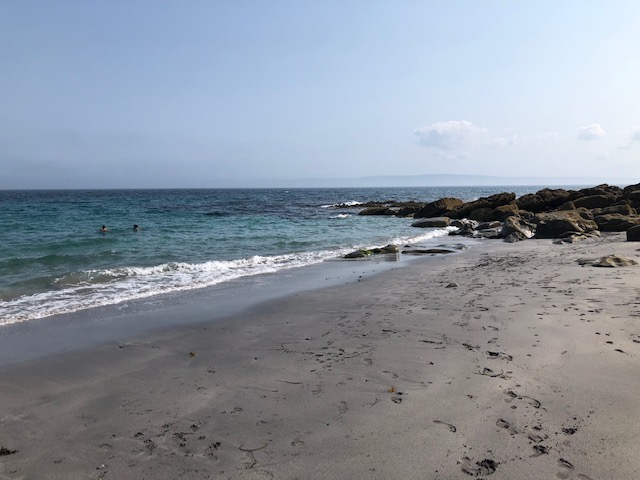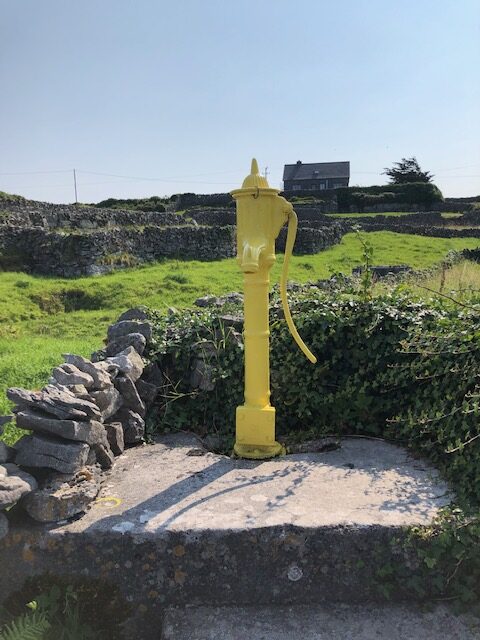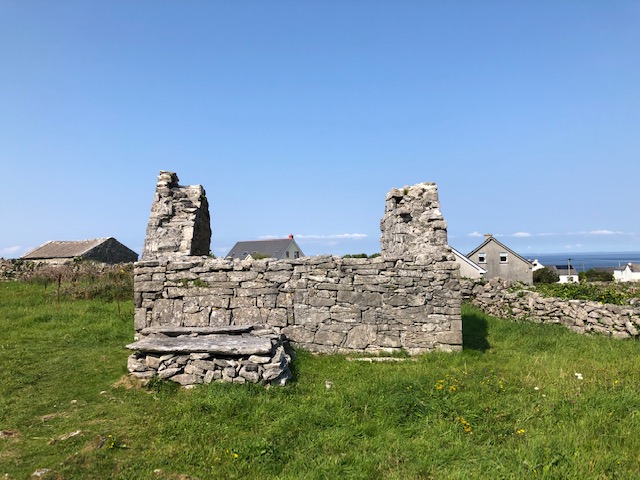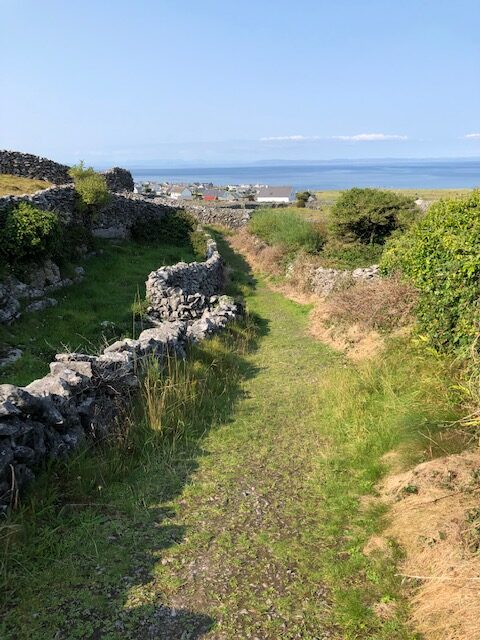Inis Oírr is part of a group of three Aran Islands off the west coast of Ireland. Visiting Inis Oirr is a fantastic day trip and I would highly recommend getting a ferry (or a plane) over if you find yourself in this part of Ireland.
The Aran Islands
Visiting Inis Oírr means going to the smallest of the three Aran Islands. The name of the island derives from Inis Oirthir meaning the east island. This has been anglicised to Inisheer as the english pronunciation. The two other Aran Islands are Inis Mór (Inishmore) meaning big island and Inis Meain (Inishmaan) meaning middle island. The islands are designated as a Gaeltacht region meaning that native Irish is spoken there.
Inis Oírr is the smallest of the three islands with a population of about 300 inhabitants. Although small in size there are a host of interesting sites and views to see.
Getting to Inis Oírr
Visiting Inis Oírr is relatively straightforward. The islands are located off the coast of Galway and Clare. There are daily ferry crossings from Doolin in County Clare (seasonal) and Rossaveal in County Galway (year round) that bring you to Inis Oírr. The journey time from Doolin is about 30 minutes and roughly an hour from Rossaveal.
Doolin2Aran Ferries, Doolin Ferry Co and Aran Island Ferries are the three main operators offering sailing options.
The ferry operators from Doolin also offer crossings that take in Cliffs of Moher tours as well as visiting Inis Oírr. These are quite popular in the Summer months.
Despite having a population of 300 and a land mass of about 6 square kilometres, visiting Inis Oírr is also possible by plane with a (very) small airport on the island! Flying to Inis Oírr is via Aer Arann and comes from Connemara Airport to the Island.
My Visit to Inis Oírr
I was in Clare hiking around the Burren Way at the end of August in 2021. Having finished the Burren Way, my original plan was to walk from my end point of Corofin to my base in Lahinch. I had plotted a route through back roads to achieve this. However, the last couple of days of the Burren Way had been mostly road walking. So the thoughts of another 24km of the same didn’t really appeal to me as I reached the end of my trail.
Taxi Awaits
I discussed my options with the welcoming owner on my arrival at the Corofin Country House B&B. The suggestion of a day trip spent visiting Inis Oírr appealed to me. She kindly offered to arrange a taxi to collect me the following morning at 9.30am. I thanked her and left to find food and drinks in Corofin to celebrate my completion of the Burren Way.
And so, I woke up (slightly) bleary-eyed the following morning to the realisation that I had enough cash to pay for my B&B stay or my taxi journey. But not enough for both. So, after scoffing down a very tasty breakfast, I raced into the village of Corofin to grab some cash from the ATM in the village Centra shop.
The Ferry When Visiting Inis Oírr
I arrived back just as the taxi was pulling in. After settling my B&B bill (€67.50), I jumped in the taxi. It took about 25 minutes to get back to my car in Lahinch with the fare coming in at €25. My plan was to get the 11am ferry from Doolin to Inis Oírr. My drive from Lahinch to Doolin took about 20 minutes so I had plenty of time.
Arriving at the pier in Doolin, I made my way towards the Ferry booking kiosks to make sure there was still space available on the 11am sailing.
From this point on, things started to get a bit rushed. The Ferry operator advised me that there was a sailing going in the next two minutes! I panicked a bit and agreed to go on the earlier boat before realising that I still needed to pay for parking and get my bag prepped for the day-trip. The result of which being that I ended up the last person to get on the ferry and failed to pack any water or sun cream.
I evaluated my situation as I took in the stunning views on the journey over (amazing views back over the Cliffs of Moher). Water wise I would be ok. I could just buy some on the island. Lack of sun cream was a trickier problem as the temperature was already rising. Today was looking like a scorcher. I’d just have to stick to the shade as much as I could. Spoiler alert – I found no shade when visiting Inis Oírr and got quite sunburnt.
Arrival on the Island

The ferry journey lasted about half an hour and I set down on the pier at Inis Oírr shortly after 11am. The morning so far had been a bit of a mad rush. I decided to slow the pace down a bit. First step – I stopped into a little café and ordering a coffee. I sat outside at one of the little tables available to customers and contemplated my next steps.

To Walk or Cycle
Visiting Inis Oírr allows you to sample two designated walking routes on the island. The 8 km Lúb Ceathrú an Locha walk and the 13 km Lúb Ceathrú an Phoillín. While these routes do cover many of the attractions of the island, it felt a little constricting to follow a set route in such an open and inviting space. The island is begging to be explored and the idea of hiring a bike and having a general wander around really appealed to me.
There are a couple of bike hire stalls right off the pier. Just pick out one you like and take it for a test spin. Once you’re happy with the bicycle, it’s a €10 fee to rent for the day.
Starting to Explore
So, bike rented and stocked up on water; I was ready to go and see the sites of Inis Oírr. The below map gives an outline of locations for places of interest on the island

Cnoc Raithní
Cnoc Raithní is the oldest known settlement on Inis Oírr dating back to 2000 – 1500 BC. The site is very close to the beach in Inis Oírr and lay covered in sand until a fierce storm in 1885. Subsequent excavations discovered bronzeworks and jars of cremated human remains. The castle and signal tower in the hills overlooking the site and the surrounding modern buildings gives the area a sense of living through the ages.

GAA Pitch
Despite my advancing years, every time I see a GAA pitch I get the urge to out and kick a ball around. The football pitch in Inis Oírr is set in some of the most fantastic surroundings I have ever seen a Gaelic grounds. Right beside the above mentioned Cnoc Raithní, overlooked by O’Brien’s Castle and the imposing signal tower and with a golden sandy beach and the Atlantic Ocean within a stone’s throws distance.

Airport
I’m not really sure why but the one runway airport in Inis Oírr is one of my favourite things in the island. It just feels out of place with the remoteness of the island to hear the sound of a plane overhead readying to land.

Beaches
I’ve mentioned the main beach beside the pier and Cnoc Raithní. This is the busier of the two beaches on Inis Oírr and was thronged with people on the nice sunny day I visited the island. There is a smaller more secluded beach to the north east of the island also. The sand might be a little greyer but it’s still a lovely spot.

The Lake and the Plassy Shipwreck
The most popular attraction on Inis Oírr seems to be the rusted shipwreck of the Finnish vessel known as The Plassy. As I followed the crowds moving in various methods towards the wreck (both horse and tractor drawn jarveys, walkers and other cyclists), I passed by the island’s only freshwater lake known as An Loch Mór (the big lake). I took a moment to navigate away from the main route to the Plassy to get closer to the lake. Here I get more of a sense of the island. The bustling nature of the area around the pier is only one side of Inis Oírr. Standing by the lakeshore I was able to take in the solitude and remoteness of the place. The stillness and peaceful nature of things is a lovely feeling.

I took my time by the lakeshore before heading on towards the beached shipwreck. It’s strange that a feature like this has become such a tourist attraction. Part of the reason is of course that the wreck appears on the opening credits of the famous Father Ted television show. The size of the vessel is pretty spectacular as well. I guess the fact that it’s so out of place makes the whole things quite a surreal experience. In any event, the ship washed up on the island since a storm in 1960 and has been a focal point ever since.

The Lighthouse
The large crowds that gather attract the local entrepreneurs to the Plassy wreck and I was more than happy to buy an ice cream from one of them before setting off on my way again. This time towards the Inis Oírr lighthouse. To get to the lighthouse I looped around the other side of the lake before turning south towards the lighthouse itself.
The lighthouse was built in 1857 and is still operational.

Memorial Stone
I made my way to the west of the Island to investigate the seal colony there. Unfortunately, I didn’t see any of the animals. The western side of the island does have an item which is all too familiar in coastal communities across island. I found the memorial to those lost at sea around Inis Oírr a very nicely designed stone monument.

Church of Saint Gobhnait
I continued on my meandering cycle across the island and soon I met the next local attraction. This time, the Church of Saint Gobhnait. Gobhnait was an Irish saint born in Clare in the sixth century. She sought out a life of solitude and dedication to God, similar to other monks and religious people of the time, like the the monks who lived in beehive huts on the remote and isolated Sceilg Mhichíl. Today on Inis Oírr, the remnants of St. Gobnait’s tiny chapel remain.
O’Brien’s Castle and The Signal Tower
The buildings that dominate the skyline of Inis Oírr are the ruins of the castle and signal towers located at the highest point of the island. The road to get to the ruins is very steep and I needed to walk the bicycle up the hill as I neared the top.
O’Brien’s Castle was built on the site of a previous fort called Dún Formna estimated to date back to around 400 BC. The castle itself is a newer construction, being built in the 14th century by the O’Brien family. The Aran Islands were a strategically important location in the battle for controlling access to Galway Bay. The O’Brien’s held the castle until 1582 before the settlement was lost to the O’Flaherty family from Connemara. The islands were held in Irish hands until 1652 when they were surrendered to invading Cromwell forces.
The nearby signal tower is a much newer additional to the island. Built in 1804 as part of a network of lookout stations built by the British who were fearful of an invasion by Napoleon.

The South of the Island
Having a bike gave me the opportunity to make longer forays along the various narrow roadways that stretch to the south of the island. I really enjoyed these. I experienced the island from a different angle. Plus, I seemed to have the whole place to myself as I ventured along the extremely quiet laneways. I also loved the view back to the mainland and the Cliffs of Moher. Breath-taking.
Food and Drinks
Inis Oírr has three pubs; Tigh Ned (Ned’s House), Tigh Ruairí (Rory’s House) and the Óstan Inis Oírr (Inisheer Hotel). All offer food as well as drinks. Inis Oírr also has a few coffee shops and tea rooms dotted around the island as well as stalls and kiosks near the pier selling snacks and drinks. In addition, there is a shop located between Tigh Ned and the Hotel.
Journey Home
I stood waiting at the pier at around 6 o’clock that evening. Red-faced from the day’s sun but satisfied with a very enjoyable days excursion to Inis Oírr. I found the queues for the last ferries back to the mainland extremely disorganised. I think everyone had a small fear that there wouldn’t be any room for them on the boat. Of course, when the ferries did arrive, everything worked out perfectly. I sat on the top deck enjoying the last of the sunshine and the fantastic views.
Before making my way down to the Pier for my journey home, I had sought out some shade in the beer garden of Tigh Ned. The only other table occupied in the courtyard was a group of local teenage boys. I couldn’t help but overhear their boisterous conversation. The usual teenage stuff, girls and parties etc. the only difference here was that the majority of their conversation was as Gaeilge.
My day visiting Inis Oírr had been a journey through the ages looking at sites and remnants from a huge range of eras. It was nice to catch a glimpse of what the modern Inis Oírr is; a bustling little Gaeltacht community making the most of the surrounding natural amenities.















